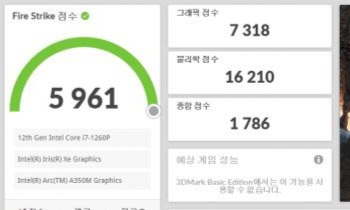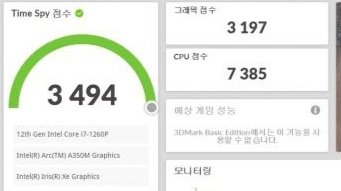Intel Arc A350M Appears Slower Than a Mobile GTX 1050 Ti in 3DMark
The first benchmarks are out
Intel's newly released Arc A350M mobile GPU has been benchmarked in 3DMark Fire Strike and Time Spy, as discovered by @harukaze5719 on Twitter. Packed within the new Samsung Galaxy Book Pro 2, performance of the A350M is on par or worse overall compared to Nvidia's mobile GTX 1050 Ti in these two specific benchmarks. Bear in mind, the GTX 1050 Ti for laptops first launched in early 2017.
The Arc 3 A350M represents the bottom SKU in Intel's new lineup of Arc Alchemist mobile GPUs. It packs six Xe cores, six ray tracing units, and a core frequency of 1150MHz. The memory bus is just 64-bits wide with a maximum memory capacity of 4GB, running on GDDR6 modules. But its power consumption is quite low with a configurable target power anywhere between 25 to 35 watts.
The Galaxy Book 2 Pro goes up to a Core i7-1260P along with the discrete Arc A350M GPU. Memory size and type were not listed, but Samsung is offering up to 16GB LPDDR5. Note that this laptop has both a "performance" mode along with a default mode according to Harukaze. The laptop was tested in both of these modes.
Samsung Galaxy Book 2 PROIntel i7 1260P + Intel ARC A530MDefault VS Performance mode3DMark Firestrike, TimeSpy pic.twitter.com/UP8mfvy9R0March 31, 2022
Unfortunately, we don't know which benchmarks were done in which mode, leaving us to make educated guesses. Nonetheless, we can still check out the notebook's highest 3DMark scores, which should demonstrate the laptop's full capabilities.
In 3DMark Fire Strike, the notebook achieved a maximum graphics score of 7,318 points, a physics score of 16,140 points and a combined score of 1,786 points. In 3DMark Time Spy the laptop managed a 3,197 graphics score and a CPU score of 7,385.
These results are not great, even by budget gaming laptop standards. For comparison, Nvidia's GTX 1050 Ti Mobile GPU from several years ago can output the same or better results in 3DMark.


In TimeSpy, there are a number of GTX 1050 Ti mobile scores that have reached a graphics score of 3,197 and higher, with the highest score being 9,336. However, there are several 1050 Ti scores far below the 3,197 score as well, so the A530M can technically (maybe) outperform the GTX 1050 Ti in Time Spy, depending on the laptops you're you're comparing it against.
The A350M is at present no match for anything newer than Nvidia's entry-level Pascal GPUs. Compared to anything newer like the GTX 1650 mobile, the lowest 3DMark Time Spy graphics scores are over 4000 points, never mind the A350M's 3200 points.
Things don't get any better in 3DMark Fire Strike for the A350M. The GTX 1050 Ti is able to handily beat the Intel GPU with a graphics score of 8,867 points compared to the A350M's 7,318 points. For reference, that 1050 Ti score is the lowest we could find in 3DMark's benchmark browser and ranks as 100th place compared to all 1050 Ti results, with the top result being 20,294 points — obviously a heavily overclocked part.
Arc 350M Driver and Optimization Concerns
While performance looks poor, we have to take these results with a grain of salt, as there are many variables that could impact the Arc A350M's results. For one, 3DMark is just one synthetic benchmark and we need to see the A350M's performance in gaming titles to get a fuller picture.
Intel also just released its Arc series of GPUs yesterday, so presumably the immature GPU drivers are a factor and things can only get better from here. There could also be performance and optimization inconsistencies with the Galaxy Book 2 Pro, which can further hinder performance.
For now, these initial results aren't promising, but we'll have to wait for additional tests and reviews, and perhaps some driver updates, before we can determine the A350M's true potential.
Get Tom's Hardware's best news and in-depth reviews, straight to your inbox.

Aaron Klotz is a contributing writer for Tom’s Hardware, covering news related to computer hardware such as CPUs, and graphics cards.
-
rtoaht For a thin and light laptop like the Galaxy Book Pro perf per watt is more important than Performance. GTX 1050Ti consumes 75-95W vs 25-30W for the Arc 350M. Also GTX 1050Ti costs $240 while 350M could be much cheaper.Reply -
EMI_Black_Ace Remember how Intel said the average price would be $75? Given that MSRP for a GTX 1050 Ti is around $150 (and much more in today's landscape) if this one is delivering that performance for $75, then I, for one, welcome our new budget gaming overlords. They're filling in a niche that Nvidia and AMD haven't bothered to compete in for the past several years. If I can get GTX 1060 performance in a desktop for circa $150 then I'm all for it.Reply -
wbfox If this is true, then there must finally be an answer: why do people keep getting all warm and fuzzy about Koduri?!Reply -
watzupken Reply
The header says GTX 1050 Ti Mobile. I don’t think the mobile version uses that much power. 75 to 90W are meant for desktop variants. But I agree that we need to see this dGPU in a bigger form factor or at least a laptop with better cooling solution to conclude.rtoaht said:For a thin and light laptop like the Galaxy Book Pro perf per watt is more important than Performance. GTX 1050Ti consumes 75-95W vs 25-30W for the Arc 350M. Also GTX 1050Ti costs $240 while 350M could be much cheaper.
Having said that, the results are not good in my opinion. While people can blame immature driver being the potential cause of the lack of performance, but if Intel can’t optimise their driver even for a short and predictable benchmark, I don’t know if they are capable of delivering decent drivers for games. Both the 3D Mark bench are also affected by the CPU score, which actually gives the Alder Lake based system an advantage, which the GPU failed to capitalise on.